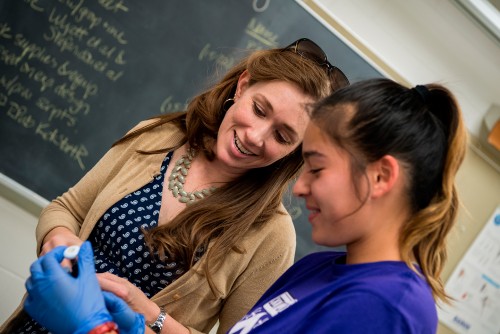Studying Neuroscience at Kenyon
As the most rapidly developing interdisciplinary area in the sciences, neuroscience integrates biology, chemistry and psychology to understand animal and human behavior. Working with faculty experts across the sciences, neuroscience students prepare for graduate training or research occupations in neuroscience, neurochemistry, neurobiology, anatomy, physiology, physiological psychology, clinical psychology, behavioral science and the health sciences.
Futures in Science
At Kenyon, students collaborate with faculty experts on research opportunities that hold the potential to change the world. In year-long programs and intensive summer projects, student researchers get specific, go deep, and immerse themselves in big questions.
-
110students a year pursue College-funded research projects in the humanities, natural sciences and social sciences.
-

Futures in Medicine
More than 90 percent of Kenyon applicants with solid grades and test scores are accepted to medical school. Learn more about premed advising.
-
$1Mgrant from the the Howard Hughes Medical Institute
The grant is one of several that Kenyon scientists have earned to foster a more inclusive and diverse scientific community.

The Write Stuff
A magazine produced by seniors in the neuroscience department shows off their ability to produce science writing for the masses.
Featured Courses
Neuroscience of College Life: Sleep and Stress
Good grades, a social life, enough sleep — they say that college students can’t have all three. But is it possible to achieve the elusive perfect balance? We’ll examine the brain physiology of stress and sleep, looking specifically at the interactions of nutrition, screen time and studying.
Animal Cognition
Can ants count? Can gorillas converse about the past or future? Do crows use tools? Can dogs read our facial expressions? We’ll examine how cognitive abilities evolved in animals and the purpose these abilities serve in their lives, as well as the implications of animal cognition for our own cognitive abilities.
Psychopharmacology
This course explores the biological mechanisms of the actions and effects of both legal and illegal psychoactive drugs — caffeine, nicotine and alcohol; cocaine, amphetamines and heroin. We’ll also discuss the action of drugs used in the treatment of mental disorders such as schizophrenia and depression.
Film, Space and Play
This course explores the relationship between neuroscience, the arts and humanities, and how the humanities and sciences are partners working together on the same problems. Examples of topics covered include the neuroscience of emotions, play behavior, film, visual and artistic perspective, space and time.
Kenyon College
Gambier, Ohio 43022

